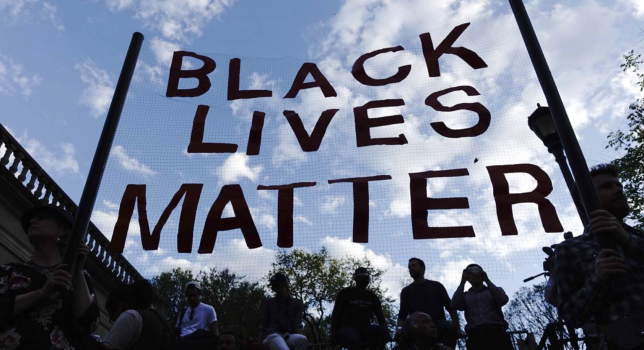Introduction
The Black Lives Matter Movement is a global social and activist movement that was created to campaign against the institutionalized racism towards black people, especially with regards to police brutality. The movement is inclusive of all black identities, including but not limited to queer, trans, disable, and undocumented black people; all black lives along this spectrum are equally important and valued.[1] Although many may view the Black Lives Matter movement as a civic movement, it does not revolve or relate to administration issues, instead the Black Lives Matter Movement should be viewed as a human rights movement.[2] The movement centers on the issue of uplifting human rights for all people, regardless of race and ethnicity, beyond the boundaries of the United States. To help the systematically targeted black community, everyone must unite together and work towards a common vision. Social media served as the catalyst for the Black Lives Matter movement, specifically Twitter, which allowed the movement to reach a greater audience and to achieve a larger impact. 
Context
History
In 2012, Trayvon Martin, an unarmed teenager, was shot on February 26 by George Zimmerman, a local neighbor in Florida.[3] During this incident, Trayvon’s father, whose name is Tracy Martin, filed a missing person report to the Sanford Police Department.[4] Following the report, investigators were able to find Trayvon’s body.[5] Despite identifying the wounds caused by Zimmerman, ranging from an open wound scalp to closed fractures, he was not charged.[6] On March 12, the Sanford Police failed to charge Zimmerman with murder, citing a lack of adequate evidence to disprove his claim.[7] Zimmerman’s father, Robert, claimed that his son was unfairly accused and portrayed as racist, despite being Hispanic and growing up in a multiracial family.[8] Several weeks later, on March 20, 2012, Trayvon’s family hired a lawyer, and found that before his murder he was on the phone with his sixteen year old girlfriend.[9] During the phone conversation, Trayvon’s girlfriend thought that his earpiece fell out, leading the connection to be disconnected. However, the results were inconclusive.[10]
Despite the unsolved case, Martin’s parents decided to pursue a petition on Change.org for the arrest of Zimmerman, resulting in more than 1.3 million people signatures.[11] As this case began to gain traction, the final debate on February 24 a year later led the jury to decipher between three central choices, which were to find Zimmerman guilty of second-degree murder, guilty of a lesser charge of manslaughter, or not guilty.[12] If the jury found Zimmerman guilty of second-degree murder, then they would have to believe that Martin’s murder with committed with ill will or hatred.[13] If the jury found Zimmerman guilty of manslaughter, then they would have to believe that he intentionally killed Martin, resulting in a 30 year prison sentence.[14] If the jury found Zimmerman not guilty, then they would have to think the case lacked sufficient evidence to convict Zimmerman.[15] On July 14, Zimmerman was found not guilty of Martin’s murder, resulting in increased racial tensions.[16] Although Zimmerman is a free man, the case has led many people, namely the Black community, to fear for their safety. For that reason, regardless that the trial is over, the race debate will continue.
Several months later, on November 23, Jordan Davis was shot at a gas station in Florida when he was purchasing gum and cigarettes with his three friends.[17] Davis and his friends were approached by Michael Dunn, a white man, who complained that they were playing too loud of music in their car.[18] After a verbal argument, Dunn shot their car, resulting in Davis’ death. Just as how this story affected Dunn, many incidents of the Black community who are being oppressed share similar stories. However, since many stories are not told in a public manner, this provided an eye-opening moment for the Black community to act upon these unjust actions.
In 2013, Patrisse Cullors, Alicia Garza, and Opal Tometi co-founded the Black Lives Matter Movement. The movement originally started as a chapter-based, member-led organization designed to unite people together in fighting against institutionalized racism.[19] The hashtag #blacklivesmatter started trending after Garza wrote a Facebook saying, “Black people. I love you. I love us. Our lives matter.”[20] Cullors responded to Garza’s post, commenting “Twin, #blacklivesmatter campaign? Can we discuss this? I have ideas. I am thinking we can do a whole social/media/all out in the streets organizing effort. Let me know.”[21] These two short and concise posts, the Black Lives Matter Movement was born. Facebook provided the necessary platform that enabled Garza and Cullors to connect with one another, bonding over the most pressing social issue in the black community. Tometi also connected with Garza and Cullors, and together they became the organizers of the Black Lives Matter Movement.[22]
Through the power of social media, many joined and supported the movement, leading to the explosive growth of the movement over a short period of time. The movement’s mission is to reimagine a world where black people are free to existand live sans racial discrimination. However, this does mean people should be “blind” to people of color. Black people, specifically black men, are more likely to killed by law enforcement agents than white people. With this in mind, supporters must challenge systemic racism in every context. Although the subject of race and racism is very important and impacts our everyday lives, it is ironically the least understood for many.[23] The reality is that race operates on a spectrum of white to black. However, this is not to say that other races do not exist, but rather these are the two focused extremes that most identify with when classifying others. For this reason, society needs to address the root causes of racial tensions, rather than using band-aid type solutions. Cultural attitudes and norms will not change unless they are challenged. More specifically, the act of the supporting Black Lives Matter Movement leads to a trickle down effect of justice. When people support what is happening with black communities, it fundamentally creates an effervescence outcome.[24] Regardless if someone is classified as Black, Latino, or Indigenous, each race matters equally on the spectrum. Thus, by focusing our attention on the people who are continuously being oppressed, namely the black community, will allow everyone to be free.
Timeline

In 2012, Trayvon Martin, an unarmed teenager, was shot on February 26 by George Zimmerman, a local neighbor in Florida.[3] During this incident, Trayvon’s father, whose name is Tracy Martin, filed a missing person report to the Sanford Police Department.[4] Following the report, investigators were able to find Trayvon’s body.[5] Despite identifying the wounds caused by Zimmerman, ranging from an open wound scalp to closed fractures, he was not charged.[6]
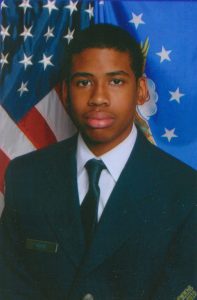
November 23, Jordan Davis was shot at a gas station in Florida when he was purchasing gum and cigarettes with his three friends.[17] Davis and his friends were approached by Michael Dunn, a white man, who complained that they were playing too loud of music in their car.[18] After a verbal argument, Dunn shot their car, resulting in Davis’ death.
In response to Alicia Garza Facebook post, Patrisse Cullor responds with the following, “twin, #blacklivesmatter campaign?…”, later looping Opal Tometi. [26]
On Twitter, the #BlackLivesMatter appears with a small appearance.

After the verdict that George Zimmerman was not guilty, wrote a Facebook post: “Black people. I love you. I love us. Our lives matter”[25]
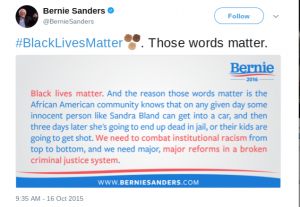
Through the help of Bernie Sanders, begins to gain traction amongst different communities of people
In the first 20 hours, #BlackLivesMatter was used on Twitter about 10,000 times. However, following the verdict, used about 92,000 times[27]
A variety of tweets were utilized, such as #icantbreathe #ericgarner. In addition to #BlackLivesMatter, additional hashtags were used to demonstrate support
Given the decentralized leadership structure of the movement, there a number of leaders who have contributed in different ways to the success of the movement. The most notable leaders are the movement’s original founders, Alicia Garza, Opal Tometi, and Patrisse Cullors. These three individuals created the movement following the verdict in the Trayvon Martin case. They created a Twitter and Tumblr page for the movement and began asking people to share their stories of why black lives matter.[28]
Key Actors
Alicia Garza is an activist and community organizer from Oakland, CA, Patrisse Cullors is an activist and artist from Los Angeles, and Opal Tometi is a writer and community organizer from New York. In addition to helping create and build momentum in the early stages of the movement, they have often serves as the face of the entire movement, though they deny being the sole leader(s) of the movement.
Another important individual is Deray Mckesson. He is an activist who is known for his visible role in protests in Ferguson, Missouri, and Baltimore.[29] Furthermore, he is the creator of Campaign Zero, which is a policy reform campaign to limit and effectively end police violence.[30]
Prominent celebrities and athletes have also publicly supported the movement, including the Weekend, Beyonce, Jay-Z, Carmelo Anthony, and Colin Kaepernick.[31] Their support has helped raise national awareness about this movement. Colin Kaepernick notably took a knee during the national anthem of NFL football games, gaining significant media attention for the movement during the 2016 and 2017 NFL seasons.[32]
Social Media Presence
Platforms Used
The Black Lives Matter Movement can be characterized by its prominent use and virality of content facilitated through social media. The movement gained popularity primarily on Twitter, as daily mentions of the movement during active periods range from tens of thousands to one million. The total number of posts with just the hashtag #BlackLIvesMatter, not including related hashtags, total over 40 million to date.[33] Facebook is also a major platform used by activists and supporters. Instagram also exhibited a significant usage rate; there have been 6.3 million posts with the associated #BlackLivesMatter.
Popular Hashtags
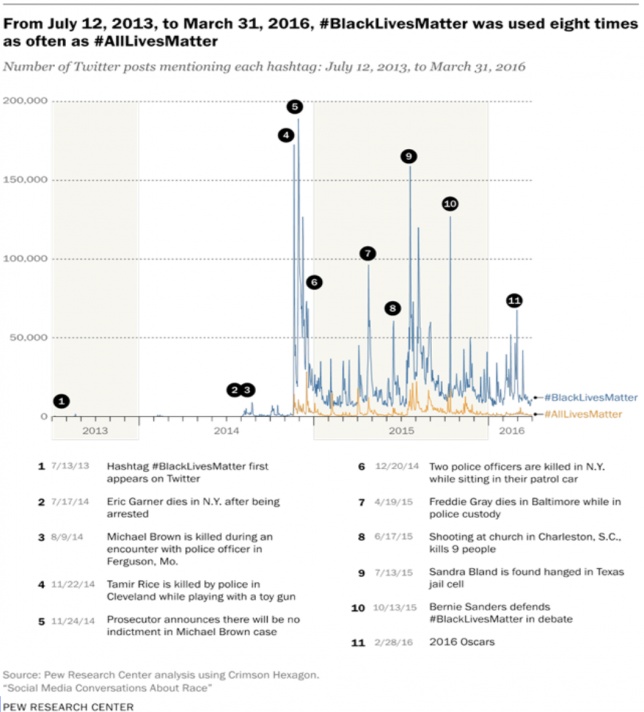
Image Source[34]
Many of the popular hashtags associated with the Black Lives Matter Movement are about the widely-known cases of police brutality against the black community.
#BlackLivesMatter
The most popular hashtag is #BlackLivesMatter. This hashtag has become the slogan of the Movement for Black Lives, and has been chanted in marches and demonstrations. It serves as a powerful slogan in responding to the growing frequency of police shootings involving unarmed black people. It is both a rally cry and political statement to help society critically examine our law enforcement and the consequences of systematic racism.
#Ferguson
Online activity dramatically increased following the death of Mike Brown, a young black man, and the court’s failure to indict the white police officer, Darren Wilson, shot him with hashtag #Ferguson.
The #BlackLivesMatter hashtag appeared an average of 58,747 times per day in the roughly three weeks following Brown’s death. However, the use of the hashtag increased dramatically three months later on November 25, the day after the Ferguson grand jury decided not to indict the officer involved in Brown’s death, the #BlackLivesMatter hashtag appeared 172,772 times. During the subsequent three weeks, the hashtag was used 1.7 million times.[35]
#ICan’tBreathe
There was a dramatic increase in tweets and hashtags following the grand jury decision of Eric Garner. #ICan’tBreathe was a response to the the choking of unarmed civilian Eric Garner by New York officer Daniel Pantaleo.
#HandsUpDontShoot
This hashtag was created as a chant response to the police shooting of Mike Brown, in which witnesses claim Brown had his hands up in the universal surrendering pose before being shot multiple times with a handgun by the officer. The officer claimed the victim charged him towards the car, while others denied this story and say Brown ran away from the officer as he was being shot.
#IfTheyGunnedMeDown
As a response to the critical and often racist media portrayal of black men, like Mike Brown, involved in police shootings, users on Twitter started an awareness campaign by posting two different photos of the same person. The first photo would be the one media outlets would use to portray them in a negative light, often holding up “gang signs” or looking like a “thug.” The second photo would be one media outlets would not publish, typically showing their achievements, merit, and good character.[36]
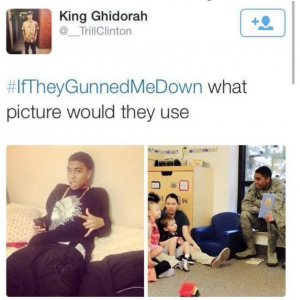
Victim Names
In addition, many of the victims of police violence have became hashtags themselves, with their names and stories going viral. The most popular ones include #MikeBrown, #EricGarner, #JohnCrawford, #WalterScott, #TamirRice, #FreddieGray, #SamuelDubose, and #SandraBland
Opposition
In response to criticisms of police brutality and violence, supporters of law enforcement agents and their current practices emphasize that the protection and well-being of police officers are important and under unfair scrutiny.18 Their response has been displayed with the usage of #BlueLivesMatter.15 BLM has been critical of #BlueLivesMatter and denies that BLM is against police or law enforcement, but rather the unethical practices and lack of accountability of law enforcement that has led to racial discrimination and profiling.
In addition, the Black Lives Matter Movement has faced criticism over the concept of “reverse racism” and some feel that the movement’s message undermines the importance of other ethnicities’ lives.15 The counter-movements collectively created the hashtag #AllLivesMatter. According to advocates of #BLM, #AllLivesMatter fails to understand and recognize the problematic nature of the cause of the term “Black Lives Matter,” and has added to the confusion and disagreement between supporters and opponents of the Black Lives Matter Movement. Proponents of this movement reason that since the justice system and law enforcement unfairly targets the black community, they must proclaim and reclaim their equality as American citizens. This movement does not negate or dehumanize the importance of other lives, but it instead aims to highlight a social issue that disproportionately affects African Americans.
On social media, the number of posts with the hashtag #AllLivesMatter coincide in frequency with those of related #BlackLivesMatter posts. #AllLivesMatter has totaled over 1.5 million posts.18 Despite rise of the usage of #AllLivesMatter, posts with this hashtag have been outnumbered 8-to-1 on Twitter by #BlackLivesMatter.
Meme vs. Cause
A majority of posts related to the Black Lives Matter Movement were created to promote the cause. Typically, posts include news or information on recent events like new police-involved shootings, jury decisions, and protests. Due to the serious subject matter, memes and other replicated visuals with comic properties are not used often on social media. Memes that are created are typically in favor of the movement, critiquing society and racism. An overwhelming margin of 3-to-1 supported Black Lives Matter.18
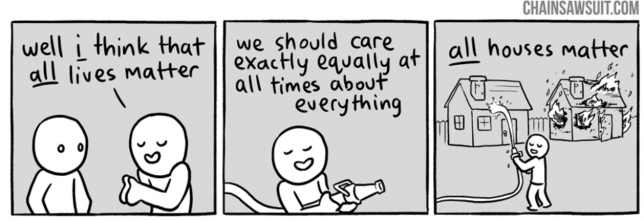

Image Source[37]
Analysis of Significance of Social Media to Movement
Social media has been instrumental in promoting the Black Lives Matter Movement. Due to the the virality and empowerment afforded by social platforms, people have been driven to challenge racial discourse and to engage in social change activism. The removal of the Confederate Flag in South Carolina from the Capitol, the federal investigations of police departments in Ferguson and Baltimore, and the pressure of presidential candidates to reveal their stances and plans of actions to address the injustices of law enforcement in the nation have all been consequences of this social movement.19 There is power in linking the tragic incidents of black people across the nation behind a hashtag to start a constructive conversation.[38] The global community is increasingly more interconnected due to the impact of social media that has forced people to confront the realities of systematic racism and discriminatory practices that overwhelmingly impact the black community.
Organic versus Planned Growth
Although the creation of Black Lives Matter Movement was planned, much of its growth has occurred organically. Following the acquittal of George Zimmerman, Alicia Garza, Patrisse Cullors, and Opal Tometi came together to create the Black Lives Matter campaign, as a call to action to address the injustices that had continued to occur against the black community.
They immediately initiated a social media strategy, creating Twitter and Tumblr accounts for the movement. They also began promoting the movement in tweets and online posts by utilizing the hashtag, #blacklivesmatter.[39] However, it wasn’t until the protests in Ferguson, a year later, that the movement really gained national and international traction. During the protests, the black lives matter chant stood out as the most prominent, and caught the nation’s attention as the protest was shared across the internet and displayed on multiple, major media outlets.[40] These protests can be thought of as the launchpad for much of the organic growth that occurred. This is evidenced by the number of “Ferguson” protests that emerged in cities and colleges across the country.[41]
Following Ferguson, much of the growth the movement experienced was centered around the subsequent shootings of young black men. Videos of these shootings rapidly shared on various social media platforms,helping to sustain the movement’s momentum.
Substantial growth occurred around the presidential election, with many protests being planned around political speeches and event. Black Lives Matter activists made appearances at campaign rallies for several political candidates, and even shut down a number of events.[42] They showed up to rallies for both Democratic and Republican candidates, with the goal of eliciting unscripted responses from candidates regarding the concerns of the black community.[43]
Following Trump’s election, Black Lives Matter activists turned their focus to opposing Trump and his policies. Trump had been generally dismissive of Black Lives Matter protesters, especially in situations where they disrupted his events.[44] Furthermore, Trump’s immigration ban also affected many Black Americans, thus providing further impetus for BLM to take action against Trump. They organized by protesting at airports and by calling for the release of detained travelers on social media.[45]
Following these events, Black Lives Matter activists have continued to organize around specific issues, events, and policies such as women’s right to choose, the display of the Confederate flag, and the Charlottesville protests.[46] The movement continues to grow today through these targeted demonstrations.
Offline presence
The movement has a strong offline presence due to its decentralized organizational structure. Black Lives Matter leadership is spread out over a number of local chapters. These chapters are not only confined to the U.S., as chapters have emerged in England, Canada, Australia, and Ghana.
As the Black Lives Matter Movement has progressed, it has increasingly become policy focused. These policy initiatives are carried out by these local chapters.[47] For example, activists in Memphis and Atlanta have focused their efforts on challenging the money bail system, and challenging the punishment for possessing a small amount of marijuana.[48]
Other cities like Minneapolis have also engaged local politicians and pushed for broader initiatives such as raising minimum wage and stronger workers’ rights.[49]
The larger impact of these local chapters is that they sustain engagement, and continue working towards policy goals, even in times when the movement’s social media presence wanes. Furthermore, the presence of local chapters allows for each chapter to focus on tackling issues most relevant to their community, compared to if they followed a unified policy agenda.
Analog Antecedents
The principal analog antecedent to this movement was the Civil Rights Movement. The Civil Rights Movement and Black Lives Matter movements shared similarities across multiple avenues. For example, both movements spread through the use of media, both involved police brutality, both were protests against the government, and both gained traction after court cases (Brown v. Board of Education and George Zimmerman). However, while the Civil Rights Movement is often used as a point of comparison for the Black Lives Matter movement, many have eschewed their direct connection. This is due to the fact that many BLM supporters view the movement as bigger than just a movement for “civil rights.” In fact, even the creators of the BLM movement have described it as being more along the lines of a human rights movement.[50] Furthermore, Black Lives Matter supporters also place emphasis on neglected parts of the African American community such as queer, trans, disabled, or migrant individuals.[51],[52]
A phrase that has been echoed regarding the Black Lives Matter movement is that it is “not your grandfather’s Civil Rights Movement.” While these movements do possess noticeable similarities, the Black Lives Matter movement prides itself on addressing issues beyond just civil rights.
A second important, and more recent, analog antecedent is the Rodney King riots. In 1991, a videotape was released of Rodney King being beaten by several police officers in Los Angeles. The tape was broadcasted on media outlets across the world, making Rodney King a symbol of racial tension and police brutality against minorities.[53] After the acquittal of the officers involved, violent riots emerged, leading to a number of arrests and a host of property damage. While this movement may not be in the minds of the current generation supporting Black Lives Matter, it served as a precedent in which police brutality against minorities was brought to mainstream consciousness.[54]
Impact of movement
In the years since the movement began, it has had a number of noticeable impacts and successes. Arguably the most important impact of the movement, however, is the increased awareness it has been able to raise about injustices against the black community. A Pew Research study supports this idea, identifying that the percentage of individuals who view racism as a major problem, especially amongst Democrats, has increased dramatically.[55] Furthermore, the movement has highlighted the persistence of racism in America, and structural issues in America’s legislative system which systematically target the black community. Such issues include the war on drugs and mass-incarceration of black people.
The movement has built such awareness by focusing its efforts on addressing issues such as prison reform and the war on drugs. It has been able to address such issues by emphasizing the need for prison reform, and demanding the defunding of for-profit prisons. Their efforts were evident during the 2016 presidential elections; Black Lives Matter Movement leaders were able to meet with both Democratic and Republican candidates, asking them about tense race relations and their intentions to address mass incarceration and criminal justice issues.[56]
In addition, the movement has been able to raise concerns around a host of other social and political issues. This includes issues such as displaying the Confederate flag in public spaces, racism on college campuses, and issues in the black trans community.[57]
The movement has had some notable accomplishments in these areas as well. For example, students in the University of California system were able to persuade the schools to divest $30 million in for-profit prison investments; protests over the display of the Confederate flag eventually led to its removal from the South Carolina statehouse and several other public locations; and students at Georgetown were able to get administration to rename certain campus buildings that formerly honored slave owners[58],[59].
Policy Achievements
The movement has not accomplished a plethora of policy goals. However, it was able to get some traction on prison reform during the Obama Administration. Examples include the Clemency Initiative, Banning the Box for Federal Employment, and the Smart on Crime Initiative[60],[61].
The Clemency Initiative refers to a program whereby qualified federal inmates could petition to have their sentences commuted, or reduced, by the President of the United States. This policy was in response to concerns over mass incarceration.[62],[63]
Banning the Box, refers to the box on employment forms that asks whether applicants have a criminal record, usually making former inmates ineligible for employment. This makes it difficult for many to reintegrate into society following a criminal record.
Smart on Crime resulted from a review of the criminal justice system by the attorney general in 2013, to ensure that federal laws were enforced more fairly and efficiently. This initiative was also the result of a prison reform mandate, and redirected federal resources toward the most serious crimes.[64],[65]
Furthermore, it is important to note that the movement, from its inception, has not been primarily policy focused, but it has slowly adapted to having a set of policy initiatives and being more policy-focused.[66] These initiatives, which are visible on the Vision for Black Lives website, can be separated into six categories— ending the war on black people, reparations, invest-divest, economic justice, community control, and political power. Within these initiatives are more specific demands, but overall these categories represent a framework for policy goals that the movement hopes to achieve in the future.[67],[68]
Critiques of the Movement
As with any social movement, the Black Lives Matter Movement has been met with a plethora of criticisms regarding its tactics, goals, and societal effects. Individuals such as Sheriff David Clarke of Milwaukee County and Sergeant Demetrick Pennie of Dallas Police Department have openly criticized black lives matter for being anti-police and inciting a “race war.” Other criticisms have highlighted that black victims of shootings are proportionately low compared to white victims, and that therefore the Black Lives Matter Movement is based on a lie.[69]
A similar concern is the Ferguson effect. This refers to the alleged change in police behavior following the Ferguson protests, in which officers are less willing to enforce the law due to fear of breaking the law. The Ferguson effect is attributed with a rise in homicide rates across major US cities, such as Chicago and Baltimore, in 2015.[70] However, the validity of this criticism, and the statistical significant of the increase in homicides, has been heavily debated with evidence on both sides.[71]
Another criticism is that the movement ignores that amount of intraracial violence in the black community ( black people killing other black people ) and instead centers the narrative solely around police killings of black people.[72] This criticism gained some notability especially after Richard Sherman, cornerback for the Seattle Seahawks, expressed such sentiments about the movement[73]. This idea has been met with heavy rebuttal, with the claim that such a criticism underscores a fundamental misunderstanding of the movement and its true message[74],[75].
The movement has also been criticized for not prioritizing women, with evidence being that more demonstrations have been organized around around the police killings of black males compared to females. However, in response to this criticism a related movement, #sayhername, was started to raise awareness about black killings of female victims.
Most importantly, the movement has faced criticism for ignoring other marginalized groups of people who have also suffered from violence or racism. This criticism is often expressed in the form of hashtags, such as #alllivesmatter or #immigrantslivesmatter. Numerous, notable individuals including the original founders of the movement have responded to this criticism with the explanation that responding to blacklivesmatter with #alllivesmatter dismisses the structural racism against black people in America and make the assumption that all lives, including those of white folks, are equally at risk in our current system.[76],[77]
Other, less notable opposers say that the movement provokes violence, and that the tactic of blocking highways and holding street protests isn’t effective in achieving the movement’s policy goals.[78]
Conclusion
The Black Lives Matter Movement has continued to adapt and gain notability since its inception following the Trayvon Martin verdict. The movement has spread beyond American borders, with local chapters all over the world. As the movement has grown, it has been faced with a host of criticism. Despite this, the movement has persisted and achieved significant recognition across international media outlets.
Black Lives Matter continues on to this day, continuously adapting to best address its goals and demands. From the beginning of this movement, social media has been a critical tool in aiding its growth and development. While the movement could have existed and succeeded without the use of social media, social media has allowed the movement to experience explosive growth, especially around critical periods of black killings, and helped it achieve worldwide recognition.
This movement is unique in that the use of social media combined with its offline presence through local chapters has laid the foundation for the movement to be able to persist, grow, and achieve its goals, even in periods where the social media presence dwindles.
[1] Garza, Alicia. Patrisse Cullors and Opal Tometi. “HerStory.” Black Lives Matter. 27 November 2017. Web. https://blacklivesmatter.com/about/
[2] Tometi, Opal and Gerald Lenoir. “Black Lives Matter Is Not A Civil Rights Movement”, Time. Web. http://time.com/4144655/international-human-rights-day-black-lives-matter/
[3] Botelho, Greg. “George Zimmerman found not guilty of murder in Trayvon Martin’s death”, CNN. Web. http://www.cnn.com/2013/07/13/justice/zimmerman-trial/index.html
[4] Ibid.
[5] Ibid.
[6] Ibid.
[7] “Trayvon Martin Shooting Fast Facts”, CNN. Web. http://www.cnn.com/2013/06/05/us/trayvon-martin-shooting-fast-facts/index.html
[8] Ibid.
[9] Ibid.
[10] Ibid.
[11] Ibid.
[12] Botelho, Greg. “George Zimmerman found not guilty of murder in Trayvon Martin’s death”, CNN. Web. http://www.cnn.com/2013/07/13/justice/zimmerman-trial/index.html
[13] Ibid.
[14] Ibid.
[15] Ibid.
[16] Ibid.
[17] “Timeline: The Black Lives Matter movement”, ABC. Web. http://www.abc.net.au/news/2016-07-14/black-lives-matter-timeline/7585856
[18] Ibid.
[19]“About”. Black Lives Matter. Union Labor. Web. https://blacklivesmatter.com/about/
[20] King, Jamilah. “How three friends turned a spontaneous Facebook post into a global phenomenon”. The California Sunday Magazine. Web. https://stories.californiasunday.com/2015-03-01/black-lives-matter/
[21] Ibid.
[22] Ibid.
[23] Alicia Garza, Patrisse Cullors and Opal Tometi. “An Interview with the founders of Black Lives Matter”. Web. https://www.ted.com/talks/alicia_garza_patrisse_cullors_and_opal_tometi_an_interview_with_the_founders_of_black_lives_matter#t-258181
[24] Alicia Garza, Patrisse Cullors and Opal Tometi. “An Interview with the founders of Black Lives Matter”. Web. https://www.ted.com/talks/alicia_garza_patrisse_cullors_and_opal_tometi_an_interview_with_the_founders_of_black_lives_matter#t-258181
[25] King, Jamilah. “How three friends turned a spontaneous Facebook post into a global phenomenon”. The California Sunday Magazine. Web. https://stories.californiasunday.com/2015-03-01/black-lives-matter/
[26] King, Jamilah. “How three friends turned a spontaneous Facebook post into a global phenomenon”. The California Sunday Magazine. Web. https://stories.californiasunday.com/2015-03-01/black-lives-matter/
[27] Demby, Gene. “Combing Through 41 Million Tweets To Show How #BlackLivesMatter Exploded, NPR. Web. https://www.npr.org/sections/codeswitch/2016/03/02/468704888/combing-through-41-million-tweets-to-show-how-blacklivesmatter-exploded
[28]Lowery, Wesley. “Black Lives Matter: Birth of a Movement | Wesley Lowery.” The Guardian, Guardian News and Media, 17 Jan. 2017, www.theguardian.com/us-news/2017/jan/17/black-lives-matter-birth-of-a-movement.
[29] Kang, Jay Caspian. “‘Our Demand Is Simple: Stop Killing Us.’” The New York Times, The New York Times, 4 May 2015, www.nytimes.com/2015/05/10/magazine/our-demand-is-simple-stop-killing-us.html
[30] “Campaign Zero.” Campaign Zero, www.joincampaignzero.org/#vision
[31] Price, Lydia. “How Celebrities Have Supported Black Lives Matter.” PEOPLE.com, 12 Aug. 2016, people.com/celebrity/how-celebrities-have-supported-black-lives-matter/the-weeknd
[32] Frisk, Adam. “Take a Knee Protest: Why Athletes Are Refusing to Stand for U.S. National Anthem.” Global News, 25 Sept. 2017, globalnews.ca/news/3767075/take-a-knee-why-athletes-refusing-to-stand-anthem/.
[33] Spool, Ari. “Black Lives Matter.” Know Your Meme, Know Your Meme, 20 Nov. 2017, knowyourmeme.com/memes/events/black-lives-matter.
[34] Chappell, Bill. “People Wonder: ‘If They Gunned Me Down,’ What Photo Would Media Use?” NPR, NPR, 11 Aug. 2014, www.npr.org/sections/thetwo-way/2014/08/11/339592009/people-wonder-if-they-gunned-me-down-what-photo-would-media-use.
[35] Anderson, Monica, and Paul Hitlin. “3. The hashtag #BlackLivesMatter emerges: Social activism on Twitter.” Pew Research Center: Internet, Science & Tech, Pew Research Center, 15 Aug. 2016, www.pewinternet.org/2016/08/15/the-hashtag-blacklivesmatter-emerges-social-activism-on-twitter/.
[36] Stephen, Bijan. “How Black Lives Matter Uses Social Media to Fight the Power.” Wired, Wired, 1 May 2017
[37] Straub, Kris. “Chainsawsuit by Kris Straub – three panels daily.” Chainsawsuit by Kris Straub three panels daily, Chainsawsuit, 8 Dec. 2014, chainsawsuit.com/comic/archive/2014/12/08/all-things-considered/
[38] Anderson, Monica, and Paul Hitlin. “3. The hashtag #BlackLivesMatter emerges: Social activism on Twitter.” Pew Research Center: Internet, Science & Tech, Pew Research Center, 15 Aug. 2016, www.pewinternet.org/2016/08/15/the-hashtag-blacklivesmatter-emerges-social-activism-on-twitter/.
[39] Day, Elizabeth. “#BlackLivesMatter: the Birth of a New Civil Rights Movement.” The Observer, Guardian News and Media, 19 July 2015, www.theguardian.com/world/2015/jul/19/blacklivesmatter-birth-civil-rights-movement
[40]Luibrand, Shannon. “How a Death in Ferguson Sparked a Movement in America.” CBS News, CBS Interactive, 7 Aug. 2015, www.cbsnews.com/news/how-the-black-lives-matter-movement-changed-america-one-year-later
[41]Almasy, Steve, and Holly Yan. “Protesters Fill Streets across Country as Ferguson Protests Spread Coast to Coast.” CNN, Cable News Network, 26 Nov. 2014, www.cnn.com/2014/11/25/us/national-ferguson-protests/index.html.
[42]Seitz-Wald, Alex. “Bernie Sanders Event Shut down by Black Lives Matter Activists.”MSNBC, NBCUniversal News Group, 9 Aug. 2015, www.msnbc.com/msnbc/bernie-sanders-event-shut-down-black-lives-matter-activists.
[43] Almasy, Steve, and Holly Yan. “Protesters Fill Streets across Country as Ferguson Protests Spread Coast to Coast.” CNN, Cable News Network, 26 Nov. 2014, www.cnn.com/2014/11/25/us/national-ferguson-protests/index.html.
[44]Osborne, Samuel. “Black Lives Matter Protesters at Donald Trump Washington DC Rally Invited on Stage.” The Independent, Independent Digital News and Media, 20 Sept. 2017, www.independent.co.uk/news/world/americas/us-politics/black-lives-matter-donald-trump-washington-dc-stage-invite-protesters-rally-a7956831.html.
[45] Holpuch, Amanda. “Black Lives Matter Protest Shuts down Mall of America and Airport Terminal.” The Guardian, Guardian News and Media, 23 Dec. 2015, www.theguardian.com/us-news/2015/dec/23/black-lives-matter-organizers-protest-mall-of-america.
[46]Morrison, Aaron. “After Charlottesville, BLM Groups Are Set to Stage Mass Protests against White Supremacy.” Mic, Mic Network Inc., 18 Aug. 2017, mic.com/articles/183918/after-charlottesville-blm-groups-are-set-to-stage-mass-protests-against-white-supremacy.
[47]Hing, Julianne. “’Black Lives Matter’ Goes International.” Colorlines, 13 Apr. 2017, www.colorlines.com/articles/black-lives-matter-goes-international.
[48]Ross, Janell, and Wesley Lowery. “Turning Away from Street Protests, Black Lives Matter Tries a New Tactic in the Age of Trump.” The Washington Post, WP Company, 4 May 2017, www.washingtonpost.com/national/in-trumps-america-black-lives-matter-shifts-from-protests-to-policy/2017/05/04/a2acf37a-28fe-11e7-b605-33413c691853_story.html?utm_term=.0729b8ac0685.
[49]Tigue , Kristoffer. “The Rise of Black Lives Matter Minneapolis.” MinnPost, 24 Mar. 2015, www.minnpost.com/politics-policy/2015/03/rise-black-lives-matter-minneapolis.
[50] Akindele, Toni. “Here Are The Stats: Black Lives Matter v. Civil Rights Movement.”Essence.com, 12 Oct. 2016, www.essence.com/culture/black-lives-matter-civil-rights-movement.
[51]Tometi, Opal, and Gerald Lenoir. “International Human Rights Day: Black Lives Matter.” Time, Time, 10 Dec. 2015, time.com/4144655/international-human-rights-day-black-lives-matter
[52] Kamp, Karin. “Co-Founder Alicia Garza on the Black Lives Matter Movement.”BillMoyers.com, 3 Oct. 2016, billmoyers.com/story/black-lives-matter
[53]Sastry, Anjuli, and Karen Grigsby Bates. “When LA Erupted In Anger: A Look Back At The Rodney King Riots.” NPR, NPR, 26 Apr. 2017, www.npr.org/2017/04/26/524744989/when-la-erupted-in-anger-a-look-back-at-the-rodney-king-riots
[54] Joseph, Peniel. “Why the 1992 L.A. Riots Matter Today.” CNN, Cable News Network, 28 Apr. 2017, www.cnn.com/2017/04/28/opinions/los-angeles-1992-25-years-later-opinion-joseph/index.html
[55]Neal, Samantha. “Views of Racism as a Major Problem Increase Sharply, Especially among Democrats.” Pew Research Center, 29 Aug. 2017, www.pewresearch.org/fact-tank/2017/08/29/views-of-racism-as-a-major-problem-increase-sharply-especially-among-democrats
[56]Workneh, Lilly. “11 Big Accomplishments Black Activists Achieved In 2015.” The Huffington Post, TheHuffingtonPost.com, 22 Dec. 2015, www.huffingtonpost.com/entry/11-big-accomplishments-black-activists-achieved-in-2015_us_567996bae4b0b958f6583320
[57]Workneh, Lilly. “11 Big Accomplishments Black Activists Achieved In 2015.” The Huffington Post, TheHuffingtonPost.com, 22 Dec. 2015, www.huffingtonpost.com/entry/11-big-accomplishments-black-activists-achieved-in-2015_us_567996bae4b0b958f6583320
[58]Song, Jason. “UC System Divests $30 Million in Prison Holdings amid Student Pressure.”Los Angeles Times, Los Angeles Times, 26 Dec. 2015, beta.latimes.com/local/education/la-me-uc-divestment-prisons-20151226-story.html.
[59]Shaver, Katherine. “Georgetown University to Rename Two Buildings That Reflect School’s Ties to Slavery.” The Washington Post, WP Company, 15 Nov. 2015, www.washingtonpost.com/local/georgetown-university-to-rename-two-buildings-that-reflect-schools-ties-to-slavery/2015/11/15/e36edd32-8bb7-11e5-acff-673ae92ddd2b_story.html?utm_term=.005f099feb25.
[60]Dunne, Grainne. “Four Ways the Obama Administration Has Advanced Criminal Justice Reform.” Four Ways the Obama Administration Has Advanced Criminal Justice Reform | Brennan Center for Justice, 19 May 2016, www.brennancenter.org/blog/four-ways-obama-administration-has-advanced-criminal-justice-reform
[61]Smith, David. “Obama Bans Solitary Confinement of Juveniles in Federal Prisons.” The Guardian, Guardian News and Media, 25 Jan. 2016, www.theguardian.com/us-news/2016/jan/26/obama-bans-solitary-confinement-of-juveniles-in-federal-prisons
[62]“Clemency Initiative.” The United States Department of Justice, 23 Apr. 2014, www.justice.gov/pardon/clemency-initiative.
[63]Kraus, Jacob. “Revitalizing the Clemency Process.” The Free Library, 19 Jan. 2017, www.thefreelibrary.com/Revitalizing+the+clemency+process.-a0457828308.
[64]“The Attorney General’s Smart on Crime Initiative.” The United States Department of Justice, 12 Aug. 2013, www.justice.gov/archives/ag/attorney-generals-smart-crime-initiative.
[65]Chung, Ed. “Smart on Crime: An Alternative to the Tough vs. Soft Debate.” Center for American Progress, 12 May 2017, www.americanprogress.org/issues/criminal-justice/news/2017/05/12/432238/smart-crime-alternative-tough-vs-soft-debate
[66] Ross, Janell, and Wesley Lowery. “Turning Away from Street Protests, Black Lives Matter Tries a New Tactic in the Age of Trump.” The Washington Post, WP Company, 4 May 2017, www.washingtonpost.com/national/in-trumps-america-black-lives-matter-shifts-from-protests-to-policy/2017/05/04/a2acf37a-28fe-11e7-b605-33413c691853_story.html.
[67]Chan, Melissa. “Black Lives Matter Releases List of Demands in Policy Agenda.” Time, Time, 1 Aug. 2016, time.com/4433679/black-lives-matter-platform-demands
[68]“Platform.” The Movement for Black Lives, policy.m4bl.org/platform/
[69] Donald, Heather Mac. “The Lies Told by the Black Lives Matter Movement.” New York Post, New York Post, 21 Mar. 2017, nypost.com/2016/09/06/the-lies-told-by-the-black-lives-matter-movement/.
[70]Rosenfeld, Richard. Documenting and explaining the 2015 homicide rise: Research directions. US Department of Justice, Office of Justice Programs, National Institute of Justice, 2016.
[71]Gross, Neil. “Is There a ‘Ferguson Effect’?” The New York Times, The New York Times, 30 Sept. 2016, www.nytimes.com/2016/10/02/opinion/sunday/is-there-a-ferguson-effect.html
[72]McWhorter, John. “Black Lives Matter Should Also Take on ‘Black-on-Black Crime’.” The Washington Post, WP Company, 22 Oct. 2015, www.washingtonpost.com/posteverything/wp/2015/10/22/black-lives-matter-should-also-take-on-black-on-black-crime/?utm_term.
[73]Stephen Cohen on September 16, 2015 at 2:46 PM. “Seattle Seahawks’ Richard Sherman Addresses ‘Black Lives Matter’ after Post Falsely Attributed to Him.” Seattle Seahawks & NFL News, 26 Oct. 2016, blog.seattlepi.com/football/2015/09/16/seattle-seahawks-richard-sherman-addresses-black-lives-matter-after-post-falsely-attributed-to-him
[74]Smith, Mychal Denzel. “The Movement Against Police Violence Isn’t Ignoring ‘Black-on-Black Crime’.” The Nation, 29 Oct. 2015, www.thenation.com/article/the-movement-against-police-violence-isnt-ignoring-black-on-black-crime
[75]Hafner, Josh. “Why Black Lives Matter Doesn’t Focus on ‘Black-on-Black’ Crime.” USA Today, Gannett Satellite Information Network, 27 July 2016, www.usatoday.com/story/news/nation-now/2016/07/27/why-doesnt-black-lives-matter-doesnt-focus-talk-about-black-black-crime/87609692
[76] Garza, Alicia. “A Herstory of the #BlackLivesMatter Movement by Alicia Garza.” The Feminist Wire, 12 July 2016, www.thefeministwire.com/2014/10/blacklivesmatter-2
[77]Harriot, Michael. “For White People Who Compare Black Lives Matter to White Supremacy.”The Root, Www.theroot.com, 23 Aug. 2017, www.theroot.com/for-white-people-who-compare-black-lives-matter-to-whit-1798349198
[78] Reynolds, Barbara. “I Was a Civil Rights Activist in the 1960s. But It’s Hard for Me to Get behind Black Lives Matter.” The Washington Post, WP Company, 24 Aug. 2015, www.washingtonpost.com/posteverything/wp/2015/08/24/i-was-a-civil-rights-activist-in-the-1960s-but-its-hard-for-me-to-get-behind-black-lives-matter/.

